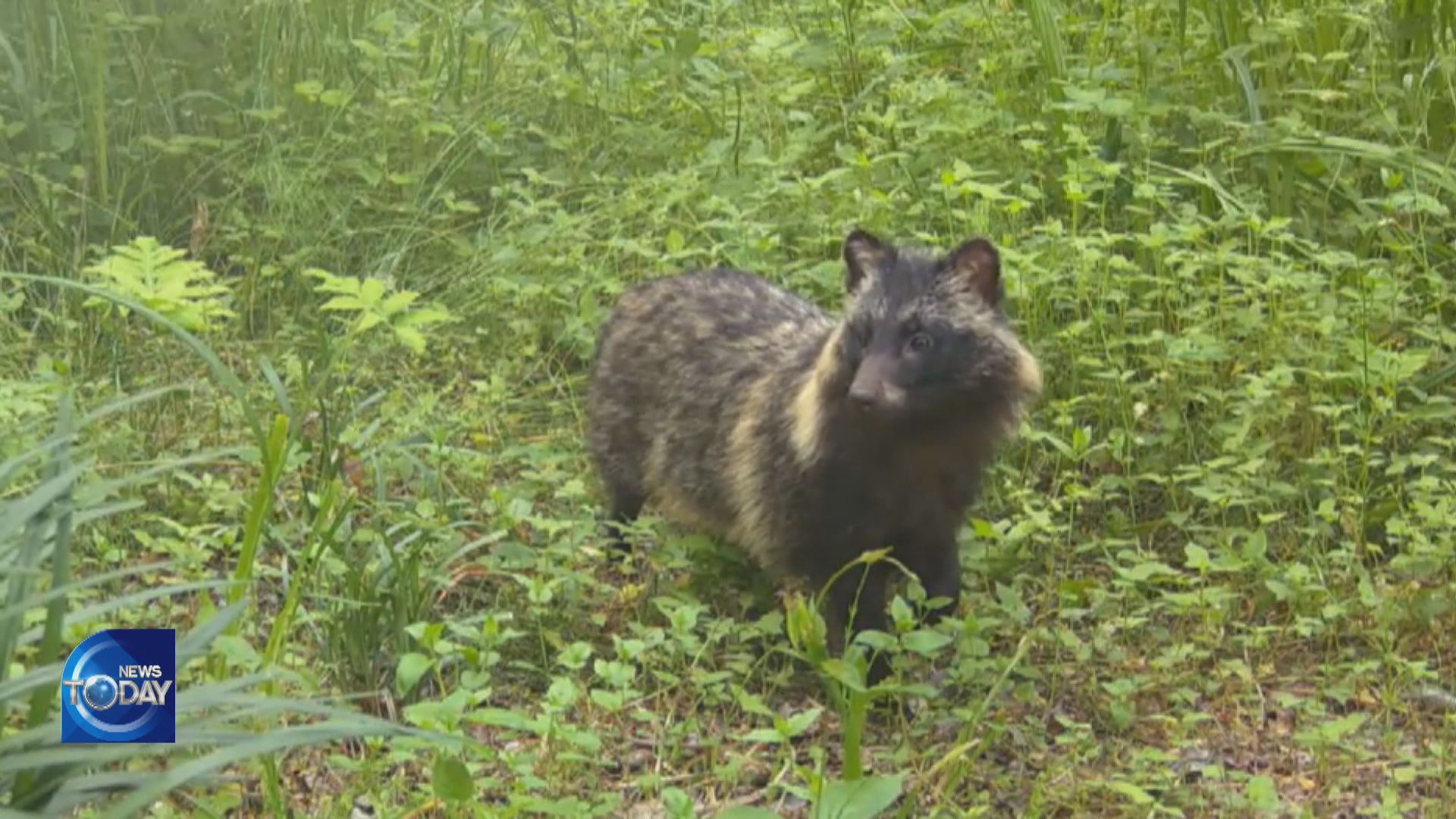CITIZENS MAKE ECOLOGICAL DISCOVERIES
입력 2022.12.27 (15:10)
수정 2022.12.27 (16:45)
읽어주기 기능은 크롬기반의
브라우저에서만 사용하실 수 있습니다.
[Anchor Lead]
It's not often we get to see wild-life animals in residential areas. An ecological survey team comprised of about 180 ordinary citizens monitored a mountain located in Goyang Gyeonggido Province, and found a total of 779 species, including raccoons, inhabiting in the area.
[Pkg]
Jeongbalsan Park was built when Ilsan City was first being developed. It was in this park that a male raccoon was captured on camera in June. About a month later, five more raccoons, including three kits, were observed at night. Multiple raccoon footprints were found when a reporter went to the park with the civil ecological survey team that filmed the raccoons.
[Soundbite] "You can see the claw marks at the end of the toes. (You can distinguish these toes?) Yes."
[Soundbite] Lee Eun-jeong(Jeongbalsan Civil Ecological Survey Team) : "We shouted in joy for finding mammals in this mountain isolated like an island in a metropolitan of 1.08 million people. And raccoons at that."
The ecological survey team comprised of about 180 ordinary citizens monitored the mountain area twice a month from the months of March to November. They found a total of 779 species, including these raccoons, inhabiting Jeongbalsan Mountain. They also discovered weasel excrements and mole tunnels as well as three natural monuments such as the Chinese sparrow hawk and endangered species including the bean goose and the prickly water lily. Also found were giant Asian mantis, which generally lives in the southern region, and fourteen other national climate-sensitive biological indicator species. These are the results of so-called “civil science” or scientific activities performed by ordinary citizens.
[Soundbite] Han Dong-uk(Director, ECO KOREA and PGAI) : "Civil science involves frequent observations. Scientists lead science, but civil participation allows the data gathered by scientists and citizens to come together to produce even richer data."
The city of Goyang plans to incorporate these civilian findings in its construction of an ecological axis that connects Jeongbalsan Mountain, Ilsan Lake Park and Janghang Wetland.
It's not often we get to see wild-life animals in residential areas. An ecological survey team comprised of about 180 ordinary citizens monitored a mountain located in Goyang Gyeonggido Province, and found a total of 779 species, including raccoons, inhabiting in the area.
[Pkg]
Jeongbalsan Park was built when Ilsan City was first being developed. It was in this park that a male raccoon was captured on camera in June. About a month later, five more raccoons, including three kits, were observed at night. Multiple raccoon footprints were found when a reporter went to the park with the civil ecological survey team that filmed the raccoons.
[Soundbite] "You can see the claw marks at the end of the toes. (You can distinguish these toes?) Yes."
[Soundbite] Lee Eun-jeong(Jeongbalsan Civil Ecological Survey Team) : "We shouted in joy for finding mammals in this mountain isolated like an island in a metropolitan of 1.08 million people. And raccoons at that."
The ecological survey team comprised of about 180 ordinary citizens monitored the mountain area twice a month from the months of March to November. They found a total of 779 species, including these raccoons, inhabiting Jeongbalsan Mountain. They also discovered weasel excrements and mole tunnels as well as three natural monuments such as the Chinese sparrow hawk and endangered species including the bean goose and the prickly water lily. Also found were giant Asian mantis, which generally lives in the southern region, and fourteen other national climate-sensitive biological indicator species. These are the results of so-called “civil science” or scientific activities performed by ordinary citizens.
[Soundbite] Han Dong-uk(Director, ECO KOREA and PGAI) : "Civil science involves frequent observations. Scientists lead science, but civil participation allows the data gathered by scientists and citizens to come together to produce even richer data."
The city of Goyang plans to incorporate these civilian findings in its construction of an ecological axis that connects Jeongbalsan Mountain, Ilsan Lake Park and Janghang Wetland.
■ 제보하기
▷ 카카오톡 : 'KBS제보' 검색, 채널 추가
▷ 전화 : 02-781-1234, 4444
▷ 이메일 : kbs1234@kbs.co.kr
▷ 유튜브, 네이버, 카카오에서도 KBS뉴스를 구독해주세요!
- CITIZENS MAKE ECOLOGICAL DISCOVERIES
-
- 입력 2022-12-27 15:10:58
- 수정2022-12-27 16:45:06

[Anchor Lead]
It's not often we get to see wild-life animals in residential areas. An ecological survey team comprised of about 180 ordinary citizens monitored a mountain located in Goyang Gyeonggido Province, and found a total of 779 species, including raccoons, inhabiting in the area.
[Pkg]
Jeongbalsan Park was built when Ilsan City was first being developed. It was in this park that a male raccoon was captured on camera in June. About a month later, five more raccoons, including three kits, were observed at night. Multiple raccoon footprints were found when a reporter went to the park with the civil ecological survey team that filmed the raccoons.
[Soundbite] "You can see the claw marks at the end of the toes. (You can distinguish these toes?) Yes."
[Soundbite] Lee Eun-jeong(Jeongbalsan Civil Ecological Survey Team) : "We shouted in joy for finding mammals in this mountain isolated like an island in a metropolitan of 1.08 million people. And raccoons at that."
The ecological survey team comprised of about 180 ordinary citizens monitored the mountain area twice a month from the months of March to November. They found a total of 779 species, including these raccoons, inhabiting Jeongbalsan Mountain. They also discovered weasel excrements and mole tunnels as well as three natural monuments such as the Chinese sparrow hawk and endangered species including the bean goose and the prickly water lily. Also found were giant Asian mantis, which generally lives in the southern region, and fourteen other national climate-sensitive biological indicator species. These are the results of so-called “civil science” or scientific activities performed by ordinary citizens.
[Soundbite] Han Dong-uk(Director, ECO KOREA and PGAI) : "Civil science involves frequent observations. Scientists lead science, but civil participation allows the data gathered by scientists and citizens to come together to produce even richer data."
The city of Goyang plans to incorporate these civilian findings in its construction of an ecological axis that connects Jeongbalsan Mountain, Ilsan Lake Park and Janghang Wetland.
It's not often we get to see wild-life animals in residential areas. An ecological survey team comprised of about 180 ordinary citizens monitored a mountain located in Goyang Gyeonggido Province, and found a total of 779 species, including raccoons, inhabiting in the area.
[Pkg]
Jeongbalsan Park was built when Ilsan City was first being developed. It was in this park that a male raccoon was captured on camera in June. About a month later, five more raccoons, including three kits, were observed at night. Multiple raccoon footprints were found when a reporter went to the park with the civil ecological survey team that filmed the raccoons.
[Soundbite] "You can see the claw marks at the end of the toes. (You can distinguish these toes?) Yes."
[Soundbite] Lee Eun-jeong(Jeongbalsan Civil Ecological Survey Team) : "We shouted in joy for finding mammals in this mountain isolated like an island in a metropolitan of 1.08 million people. And raccoons at that."
The ecological survey team comprised of about 180 ordinary citizens monitored the mountain area twice a month from the months of March to November. They found a total of 779 species, including these raccoons, inhabiting Jeongbalsan Mountain. They also discovered weasel excrements and mole tunnels as well as three natural monuments such as the Chinese sparrow hawk and endangered species including the bean goose and the prickly water lily. Also found were giant Asian mantis, which generally lives in the southern region, and fourteen other national climate-sensitive biological indicator species. These are the results of so-called “civil science” or scientific activities performed by ordinary citizens.
[Soundbite] Han Dong-uk(Director, ECO KOREA and PGAI) : "Civil science involves frequent observations. Scientists lead science, but civil participation allows the data gathered by scientists and citizens to come together to produce even richer data."
The city of Goyang plans to incorporate these civilian findings in its construction of an ecological axis that connects Jeongbalsan Mountain, Ilsan Lake Park and Janghang Wetland.
이 기사가 좋으셨다면
-
좋아요
0
-
응원해요
0
-
후속 원해요
0

















이 기사에 대한 의견을 남겨주세요.